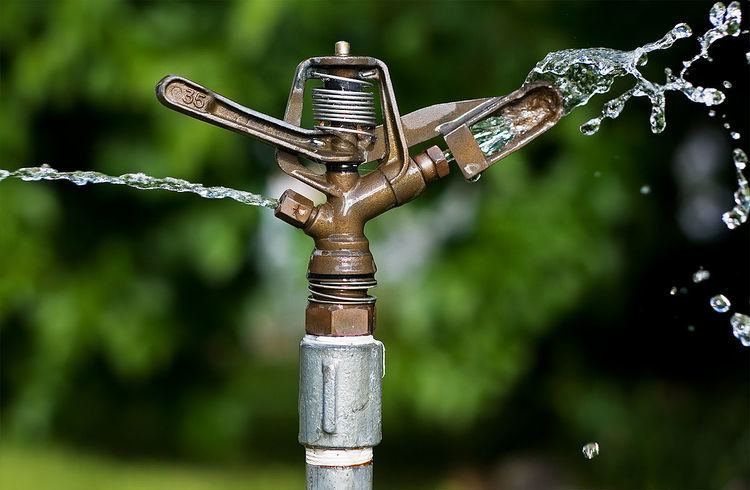 | ||
Irrigation sprinklers are sprinklers providing irrigation to agriculture, crops, vegetation, or for recreation, as a cooling system, or for the control of airborne dust, landscaping and golf courses. The sprinkler system irrigates the field and thus it is widely used in sandy areas as it checks the wastage of water through seepage and evaporation. Sprinkler irrigation is a method of applying irrigation water which is similar to natural rainfall. Water is distributed through a system of pipes usually by pumping. It is then sprayed into the air through sprinklers so that it breaks up into small water drops which fall to the ground. The pump supply system, sprinklers and operating conditions must be designed to enable a uniform application of water.
Contents
Industrial
Sprinklers that spray in a fixed pattern are generally called sprays or spray heads. Sprays are not usually designed to operate at pressures , due to misting problems that may develop.
Higher pressure sprinklers that themselves move in a circle are driven by a ball drive, gear drive, or impact mechanism (impact sprinklers). These can be designed to rotate in a full or partial circle.
Rainguns are similar to impact sprinkler, except that they generally operate at very high pressures of 40 to 130 lbf/in² (275 to 900 kPa) and flows of 50 to 1200 US gal/min (3 to 76 L/s), usually with nozzle diameters in the range of 0.5 to 1.9 inches (10 to 50 mm). In addition to irrigation, guns are used for industrial applications such as dust suppression and logging.
Many irrigation sprinklers are buried in the ground along with their supporting plumbing, although above ground and moving sprinklers are also common. Most irrigation sprinklers operate through electric and hydraulic technology and are grouped together in zones that can be collectively turned on and off by actuating a solenoid-controlled valve.
Residential
Home lawn sprinklers vary widely in their size, cost, and complexity. They include impact sprinklers, oscillating sprinklers, drip sprinklers, and underground sprinkler systems. Small sprinklers are available at home and garden stores or hardware stores for small costs. These are often attached to an outdoor water faucet and are placed only temporarily. Other systems may be professionally installed permanently in the ground and are attached permanently to a home's plumbing system. An ingenious domestic sprinkler made by Nomad called a 'set-and-forget tractor sprinkler' was used in Australia in the 1950s. Water pressure ensured that the sprinkler slowly moved across a lawn.
Permanently installed systems may often operate on timers or other automated processes. They are occasionally installed with retractable heads for aesthetic and practical reasons (making damage during lawn mowing or other maintenance less likely). These often are programmed to operate on a schedule and irrigate a piece of land in zones.
Underground Sprinkler
Underground sprinklers function through means of basic electronic and hydraulic technology. This valve and all of the sprinklers that will be activated by this valve are known as a zone. Upon activation, the solenoid, which sits on top of the valve is magnetized lifting a small stainless steel plunger in its center. By doing this, the activated (or raised) plunger allows air to escape from the top of a rubber diaphragm located in the center of the valve. Water that has been charged and waiting on the bottom of this same diaphragm now has the higher pressure and lifts the diaphragm. This pressurized water is then allowed to escape down stream of the valve through a series of pipes, usually made of PVC (higher pressure commercial systems) or polyethylene pipe (for typically lower pressure residential systems). At the end of these pipes and flush to ground level (typically) are pre measured and spaced out sprinklers. These sprinklers can be fixed spray heads that have a set pattern and generally spray between 1.5–2m (7–15 ft.), full rotating sprinklers that can spray a broken stream of water from 6–12m (20–40 ft.), or small drip emitters that release a slow, steady drip of water on more delicate plants such as flowers and shrubs. use of indigenous materials also recommended.
Agricultural Science
The first use of sprinklers by farmers was some form of home and golf course type sprinklers. These ad hoc systems, while doing the job of the buried pipes and fixed sprinkler heads, interfered with cultivation and were expensive to maintain. In the 1950s a firm based in Portland, Oregon Stout-Wyss Irrigation System, developed the rolling pipe type irrigation system for farms that has become the most popular type for farmers irrigating large fields. With this system large wheels attached to the large pipes with sprinkler heads move slowly across the field.
Use
Most irrigation sprinklers are used as part of a sprinkler system, consisting of various plumbing parts, pump unit, piping and control equipment. Outdoor sprinkler systems are sometimes used as a deterrent against homeless people. This sprinkler system was programmed to drench unsuspecting sleepers at random times during the night. Local businessmen soon copied this system in an effort to drive homeless people away from public sidewalks adjacent to their businesses.
Health risks from aerosols
In 2014, it was reported that use of common garden hoses in combination with spray nozzles may generate aerosols containing droplets smaller than 10 μm, which can be inhaled by nearby people. Water stagnating in a hose between uses, especially when warmed by the sun, can host the growth and interaction of Legionella and free-living amoebae (FLA) as biofilms on the inner surface of the hose. Clinical cases of Legionnaires' disease or Pontiac fever have been found to be associated with inhalation of garden hose aerosols containing Legionella bacteria. The report provides measured microbial densities resulting from controlled hose conditions in order to quantify the human health risks. The densities of Legionella spp. identified in two types of hoses were found to be similar to those reported during legionellosis outbreaks from other causes. It is proposed that the risk could be mitigated by draining hoses after use.
